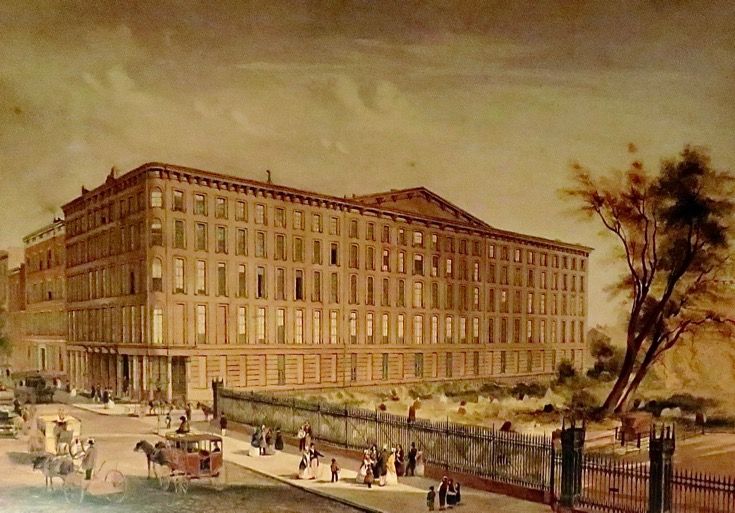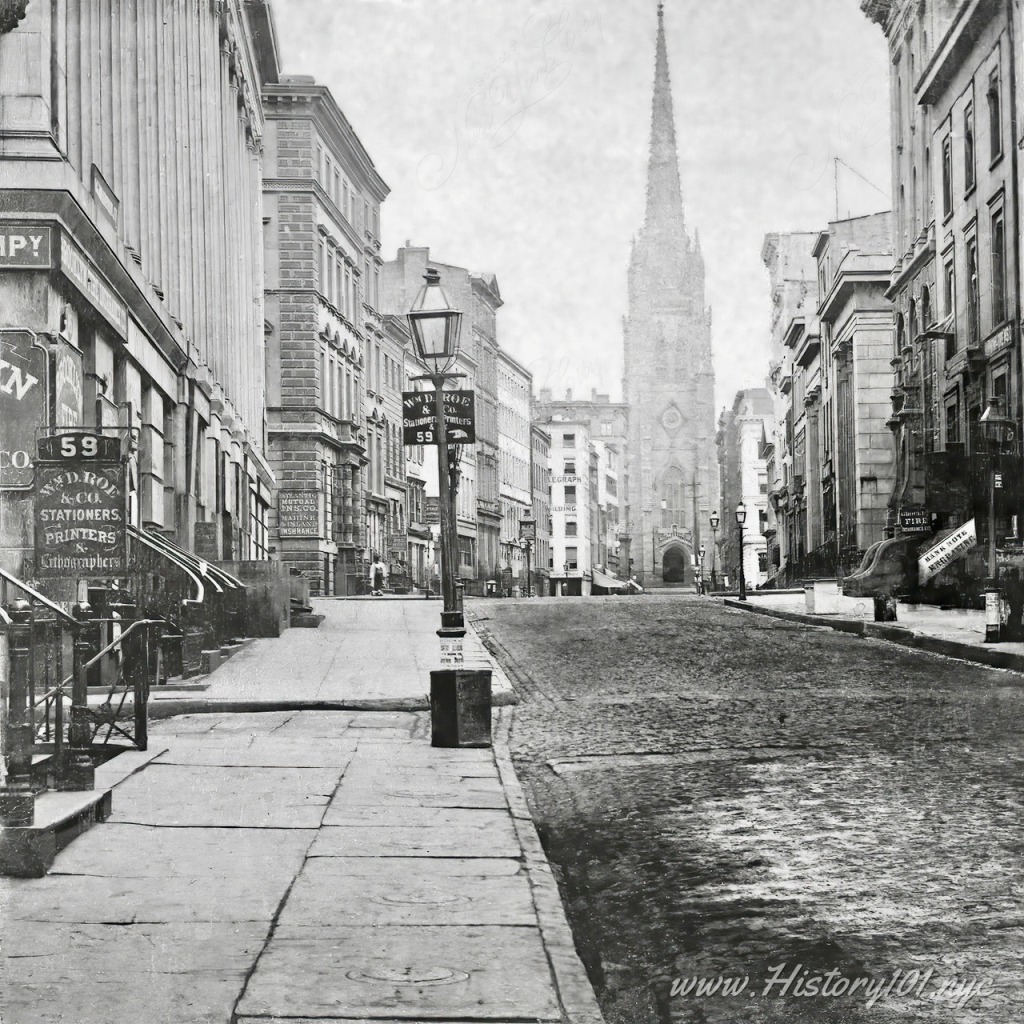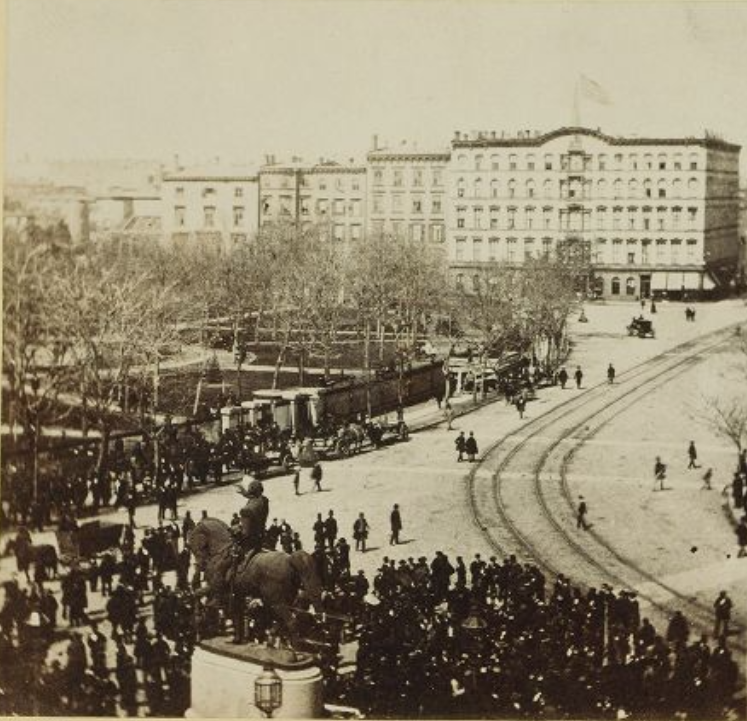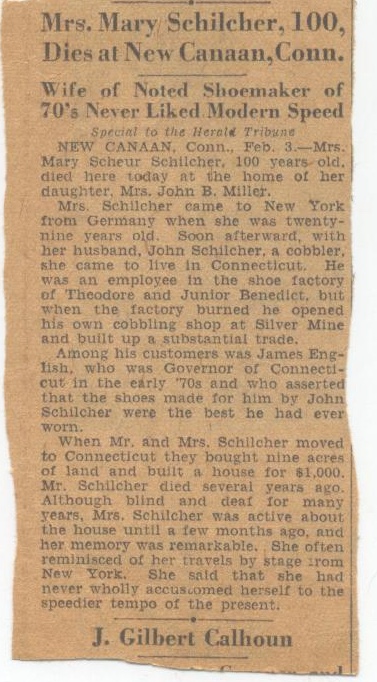Joseph SCHILCHER was born in Stoffen, Landsberg am Lech, Bavaria, May 29, 1821. His parents were Mathias SCHILCHER and Agatha DIETRICH. Landsberg am Lech is a small town in what is now Southwest Germany and this part of the world was experiencing a democratic uprising during Joseph’s early years. Visitberlin.com describes small scale uprisings by various working class groups, including tailors, beginning in 1830, which culminated in the German Revolution of 1848-1849.
It was at the end of this bloody revolution that Joseph emigrated to America, with his wife Margreth Sophia, at the age of 28. They took the ship Bark Elbe from Hamburg, arriving in New York City through Castle Garden on October 22, 1849. Joseph listed his occupation as boot maker.[1] Within the year the couple had taken up residence in lower Manhattan. On July 1, 1859, Joseph SCHILCHER became a naturalized citizen, listing his address as 7 Rector Street, New York City, at the corner of Rector Street and Trinity Place behind Trinity Cathedral in downtown Manhattan.


Photo by H. Hoyer
By the following July of 1860, Joseph and Sophie had moved out of the city and were living in New Canaan, Connecticut. New Canaan is in Fairfield County, Connecticut, on the New York border, in what is considered Connecticut’s Gold Coast.[2] It is approximately 50 miles northeast of New York City. In the 1800s, the community of New Canaan, and others in Fairfield County, were known for shoe production, and this is where Joseph came to earn his fortune. “The first (shoe) factory opened in 1768 on Brushy Ridge Road, but by the early 1800s there were numerous factories in the downtown area. At the height of production, New Canaan shoemakers produced 50,000 pairs per year.”[3]The Goodyear Metallic Rubber Shoe Co. in Naugatuck revolutionized the process of stabilizing rubber – vulcanization – and made the area a hub of industry.[4]

The couple lived with another shoemaker of similar age who hailed from Holstein, Germany. The family rented a saltbox home on Benedict Hill Road.[5] Here, on October 17, 1862, Sophie died. She was buried in Hickock Cemetery in New Canaan, less than a mile from their home.[6]






Joseph briefly moved back to New York City after the death of his wife, likely for work in the garment industry. Here he married again in October 1863. His new bride, Maria SCHEUER, was a young German immigrant who had come to New York City just a few years prior.
Maria SCHEUER was born in Kirchheimbolanden, Pfalz, Bavaria on August 6, 1831,[7] the eldest daughter of David and Maria (DAHLMANN) SCHEUER. She had an older brother, Karl, three younger sisters – Louise, Barbara, and Elizabetha – and three younger brothers – Peter, Georg, and Johannes. There was a 17-year gap between the eldest and youngest SCHEUER sibling.[8]

Kirchheimbolanden sits in southwest Germany, near what is now Frankfurt. Located in the southern portion of current Germany, this historic region is largely forested and mountainous, with river valleys used for wine production.[9] At the time of Maria’s birth, this area was under Austrian/Bavarian rule, so she would have considered herself Belgian or Bavarian, rather than Prussian or German. It was in this part of the Kingdom of Bavaria that the Palatine Uprising took place in early summer of 1849 when Maria was not yet 18 years old. In a widespread effort to adopt a constitution, and after members of parliament were unsuccessful in enacting a bill of rights, there was revolution. In June of 1849 the Prussian army crossed the border into Palatine and met the local militia at Kirchheimbolanden. The bloody battle that followed ended in a rousing defeat of the rebels.[10]

Her mother died in 1854; brother Peter died the following year, at the age of 17. The same year, in 1855, Maria’s brother Karl emigrated to America, settling in Brooklyn and changing his name to Charles. He would eventually have a large family and a well-known business in the Queens neighborhood of Oyster Bay.[11] Maria emigrated with a friend around 1860. She came to live with her brother in New York City, where she found work as a domestic. Here is where she met Joseph SCHILCHER in 1863. They were married during the height of the Civil War.
During the Civil War, New York City was a flurry of activity. Being the most populous state of the Union, New York sent more men than any other state to fight for the Union Army, a quarter of which were foreign born. Maria’s brother, now Charles, enlisted in 1861, which came with an enlistment bonus for his family. He served for 3 years in the New York 1st Calvary, Company B, first as a bugler and then a wagoner.[12]
Although Maria’s brother survived his war service, over 50,000 New York men died in the war. Needing more troops, with the war dragging into its fourth year, in March of 1863, Congress passed the Enrollment Act, in which the first national conscription law was established. This law required new and existing male citizens between ages 20-45 were required to enroll for service (blacks, however, were excluded).[13] The people of the state were divided – while there was strong support for Lincoln and emancipation, there were also groups who wanted to see early peace. Immigrants just arriving in the country were now learning they were expected to fight a war for their new country.




On July 13, 1863, the first draft drawing was held and a riot ensued. The riot lasted for three days throughout the city – buildings were burned and property destroyed, people were beaten and killed, mostly working class people of color. In total the riots left upwards of 200 dead and 2,000 wounded – 4,000 Union troops were ordered to ride from Gettysburg to suppress the riots.[14] In the end, the drafts were held and by the end of the war nearly half a million men had served from New York State.
The young couple had a daughter, Wilhelmina or Minnie, shortly after the wedding, and left New York for Wilton, Connecticut, in 1865. According to her obituary, Maria “often reminisced of her travels by stage from New York.”[15]
In April of 1869 Joseph purchased nine acres of land in the town of Wilton, which came with two buildings.[16] They built a home on this land and remained here for the rest of their time together. A son Paul was born in late 1869, followed by Carl in late 1871.[17]

For some time, Joseph worked for the Benedict & Co. shoe manufacturers, well-known for its high-end, handmade products.[18] However, he soon opened his own cobbling shop in Silvermine, an unincorporated community that includes portions of the towns of Norwalk, New Canaan and Wilton. He was known for his handmade shoes in a time when factory production was becoming the norm. According to his wife’s obituary, one customer was James English, prominent Connecticut governor and statesman, who “asserted that the shoes made for him by (SCHILCHER) were the best he had ever worn.”[19]
Joseph SCHILCHER died on September 1, 1895, at the age of 74, and was buried in Lakeview Cemetery in New Canaan.
Maria SCHEUER SCHILCHER continued to live in Wilton with her children and saw each of her children married in turn – first her son Carlton, one month after her husband’s death, then her son Paul in 1901, and finally Minnie, in 1906.
In 1910, Maria lived alone at age 78, in the home next door to her son Paul and his wife and family. Maria took pleasure in daily tending her flower garden. However, she began to lose her sight, and by the age of 80 she was blind. She continued to garden until she also lost her hearing as well, and by 1920 she was living on Silvermine Road with her daughter and her son-in-law.[20]
In 1931, when Maria turned 100, the local newspaper – the Norwalk Hour – did a special piece on her and her remarkably long life. The article, published on August 5, 1931, describes a “little white haired old lady … patiently bending over her knitting…all her life she has been an excellent knitter … which she learned as a tiny girl in Bavaria.” The article describes her enjoyment of automobile rides, and her love for bread and applesauce. Despite her age and infirmities, Maria’s disposition remained upbeat at the end of her life.
Maria died in February of 1932, at the age of 100 years and 6 months and was buried in Lakeview Cemetery alongside her husband Joseph.

[1] Passenger Lists of Vessels Arriving at New York, New York, 1820-1897; (National Archives Microfilm Publication M237, 675 rolls); Records of the U.S. Customs Service; Year: 1849; Arrival: , ; Microfilm serial: M237; Microfilm roll: M237_84; Line: 2; List number: 1441.

Passenger list Bark Elbe arriving New York City 1849 – List available at Ellis Island Visitor Center
[2] https://en.wikipedia.org/wiki/New_Canaan,_Connecticut
[3] https://newcanaanite.com/new-canaan-now-then-main-street-and-locust-avenue-5510058
[4] https://www.ctinsider.com/connecticutmagazine/news-people/article/Looking-Back-on-Charles-Goodyear-and-the-Rubber-17043651.php#photo-22266770
[5] https://archive.org/stream/landmarksofnewca00unse/landmarksofnewca00unse_djvu.txt
[6] https://www.findagrave.com/memorial/16589202/margreth-s-schilcher
[7] Deutschland Geburten und Taufen, 1558-1898, database, FamilySearch (https://familysearch.org/ark:/61903/1:1:ND9F-H8G:24 October 2021), Marie Scheuer, 1831.
[8] https://www.familysearch.org/tree/person/sources/K8YD-79Q
[9] https://en.wikipedia.org/wiki/Palatinate_(region)
[10] https://en.wikipedia.org/wiki/Battle_of_Kirchheimbolanden
[11] 1880 United States Federal Census; Place: Oyster Bay, Queens, New York; Roll: M593_1081; Page: 464A
[12] National Park Service, Civil War Soldiers and Sailors System, online <a href=”http://www.itd.nps.gov/cwss/” target=”_blank”http://www.itd.nps.gov/cwss//a>, acquired 2007.
[13] https://en.wikipedia.org/wiki/Enrollment_Act; https://en.wikipedia.org/wiki/New_York_City_draft_riots
[14] https://en.wikipedia.org/wiki/New_York_City_draft_riots
[15] The NY Herald Tribune, February 1932

[16] Original Deed of Sale; 1870 U.S. Federal Census; Wilton, Fairfield, Connecticut; Roll: M593; Page: 19; Dwelling: 177; Family: 193.

Joseph Schilcher original deed, purchase of nine acres in New Canaan, 1969
[17] 1880 U.S. Federal Census; Wilton, Fairfield, Connecticut; Roll: 95; Family History Film: 1254095; Page: 287A; Enumeration District: 120; Image: 0015.
[18] https://connecticuthistory.org/the-sole-of-new-canaans-shoe-industry/
[19] The NY Herald Tribune, February 1932
[20] 1920 U.S. Federal Census. Place: New Canaan, Fairfield, Connecticut; Roll: T625_178; Page: 1A; Enumeration District: 130